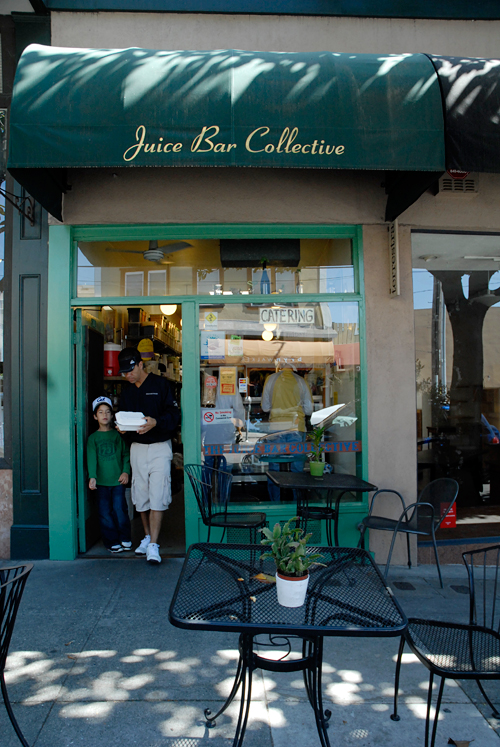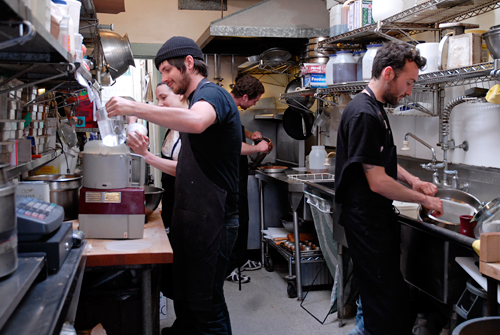
Juice Bar Collective members at work. Photo by Wendy Goodfriend
Keep Your Ideals High, Your Workers Happy...
The Juice Bar has been a worker-owned collective since its inception. While none of the original founders are still involved, two collective members have been working there for over 25 years, others for 20. Most of the newer members have been remained there anywhere from 3 to 6 years.
Job responsibilities rotate, so eventually each member takes a turn doing all the jobs needed to keep the business running, from doing the ordering and payroll to working the cash register and washing dishes. Mandatory monthly meetings are run on a one-member, one-vote system. In return, collective members share an equal hourly wage and receive full health, vision, and dental benefits, plus 4 weeks' paid vacation.
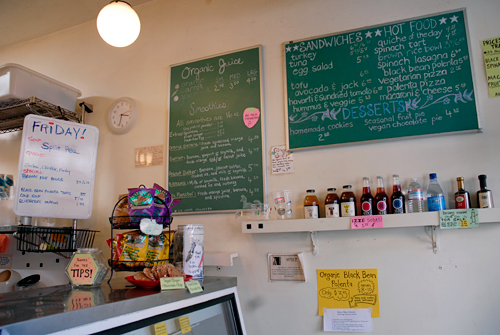
Juice Bar Collective menu. Photo by Wendy Goodfriend
...Your Menu Short
When the Juice Bar started, it offered just two things: juice and soup. The menu of made-from-scratch dishes has expanded over the years, but fresh-squeezed juices and homemade soup remain, along with a brief roster of smoothies. No room for a freezer means no frozen yogurt or sorbet in the smoothies--meaning these smoothies are pure fruit and juice with a little milk or soymilk added, not sugar-laden milkshakes in health-food disguise. The rest of the menu? A half-dozen sandwich varieties, a few veggie salads, a handful of hot dishes. Almost everything is made from scratch, mostly vegetarian and vegan, although there are tuna and turkey sandwiches, plus a much-loved turkey shepherd's pie served in the fall and winter.
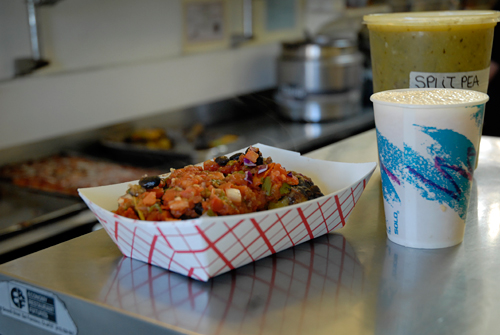
Black-bean-and-polenta casserole with salsa, soup and a smoothie. Photo by Wendy Goodfriend
Times Change, and So Should Your Casseroles
For all their much-vaunted progressiveness, Berkeleyites feel strongly that some good things should stay that way, forever. Regulars still ask, longingly, for the soybean casserole, even though it was dropped from the menu nearly a decade ago in favor of more up-to-date offerings like pizza, lasagna, and a black-bean-and-polenta casserole blanketed in a choice of melted cheese or salsa. In a town of endless potlucks, these hot dishes, sold by the tray, have proved very popular for casual catering. What bring-your-own-dinner wouldn't be improved by a panful of no-fuss, ready-to-heat lasagna or vegan polenta?
However, the brown-rice bowl, lavished with peanut sauce and topped with a rotating choice of Asian-inspired salads, remains, and that delicious peanut sauce is now also sold in tubs to go.
And soybean lovers can still enjoy chocolate-tofu pie (melted chocolate whipped into silken tofu, poured into a graham-cracker crust) and a baked garlic-and-ginger tofu sandwich.
Buy (or Barter) Local
It takes a lot of fruits and vegetables to make all those soups and smoothies. The Juice Bar gets its organic produce from the distributor Veritable Vegetable, which started in San Francisco in 1974. Asian ingredients come from Yin Hop in Oakland's Chinatown, except for tofu, which is made locally by Hodo Soy Beanery and picked up at the Thursday farmers' market on Shattuck Ave. Sonoma's Alvarado Street Bakery, a worker cooperative started in 1981, makes their sliced sandwich bread, while baguettes from the Cheeseboard are bartered for orange juice.
And Keep the Neighbors Happy
Casual trade happens up and down the street between the Juice Bar and other food businesses. Nearby merchants and workers often get a small (and usually reciprocal) courtesy discount.
Any other secrets they've learned over 35 years in business? Enthusiasm is great, but experience pays off, especially when you're hiring a crew to work elbow-to-elbow in a tiny space (something every food truck has learned the hard way). Keep your regulars happy, but don't be afraid to mix up the menu a little to keep things fresh. Make your food organic, comforting, and healthy, like what your customers would eat at home, if vegetables chopped themselves. And perfume your kitchen with the smell of melting chocolate and baking muffins whenever possible.
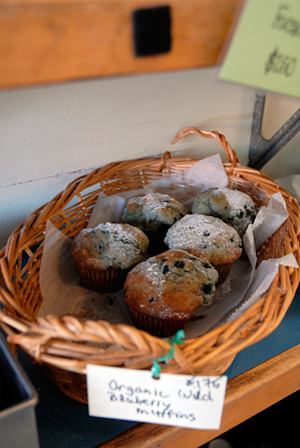
Organic Blueberry Muffins. Photo by Wendy Goodfriend
